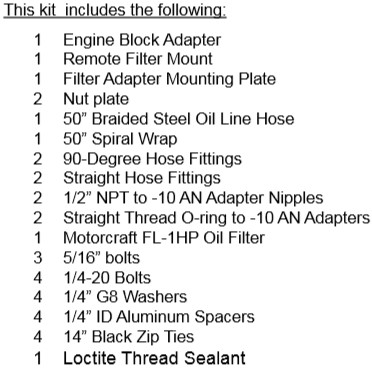
How to Install Maximum Motorsports Severe Duty Oil Filter Relocation Kit (99-01 Cobra; 03-04 Mach 1) on your Ford Mustang
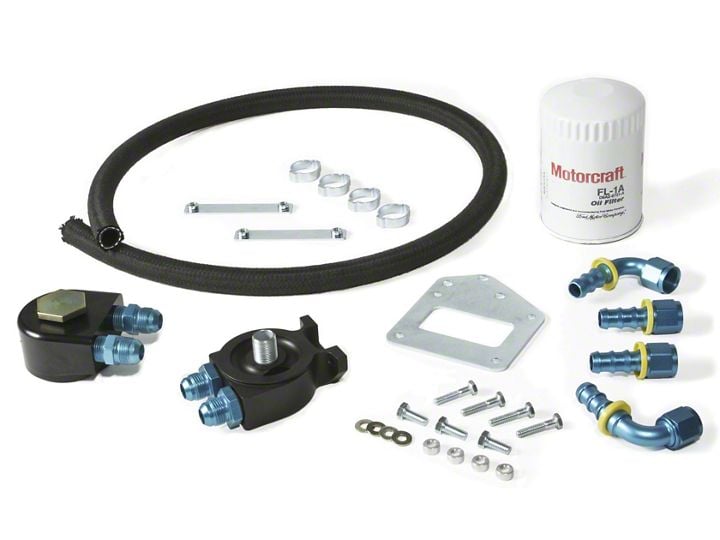
Shop Parts in this Guide
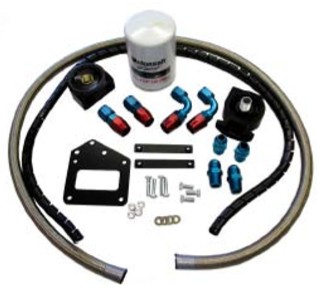
Read all of the instructions before beginning work. Following the instructions in the proper sequence will ensure the best and easiest installation.
Maximum Motorsports’ Modular Engine Oil Filter Relocation Kit moves the oil filter from the OE location to inside the driver side fender, behind the bumper support. This kit is required for all Modular DOHC and SOHC engines with OE oil coolers when installing Maximum Motorsports’ tubular K-member. Installation of this kit mandates the use of a larger volume FL-1 series oil filter (or equivalent).
1. Check the oil level and add oil, if necessary.
2. Jack up the front of the car and support securely on jackstands.
3. Remove the driver side wheel.
Filter Mount Installation
4. Remove the driver side driving light connector from the driving light. Position the connector up and out of the way.
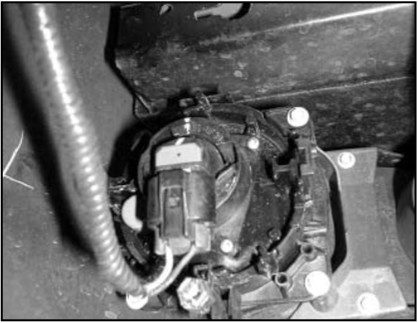
5. Position the Adapter Plate on the bumper support, and use it as a template to locate the position of the required four new mounting holes on the bumper support. Make sure that the top of the plate is lower than any protrusions from the overhead plastic panel, and that each new hole location has at least 1/8” of metal between it and any OEM holes in the bumper support.

6. Mark the location of each new mounting hole on the bumper support. Use of a clamp to hold the adapter plate to the support while marking can aid the accuracy of this step.
7. Remove the Adapter Plate from the bumper support.
8. Drill four ¼” holes at the locations marked in step 7. The bumper support is made of a steel alloy that is difficult to drill. Use high-quality, sharp drill bits. Start by drilling a 1/8” pilot hole. Then enlarge using a 3/16“ drill bit, followed by a 1/4” drill bit. The use of multiple drill bit sizes simplifies this step greatly. When drilling, the front portion of the plastic fender liner can be pulled back towards the wheel to greatly increase the room available for drill access.
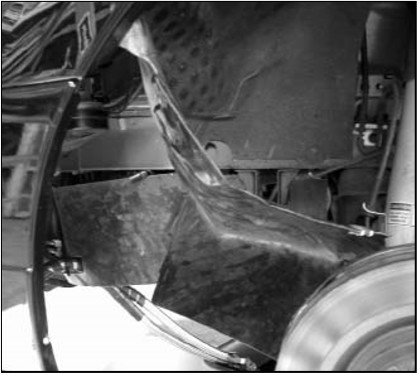
9. Apply a light coat of motor oil to the O-ring of the two Straight Thread O-ring to -10AN fittings.
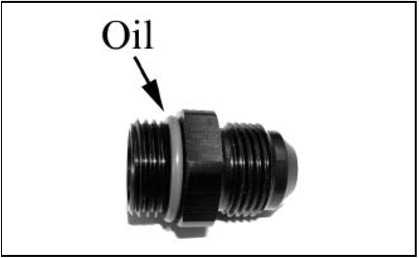
10. Place the Remote Filter Mount into a vise with “soft jaws” and install each of the two Straight Thread O-ring to -10AN fittings into the two ports of the filter adapter. Tighten the adapter nipples to 35 ft-lbs.
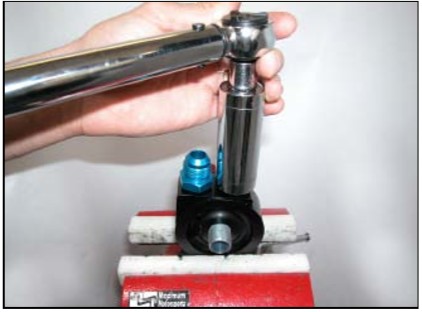
11. Attach the Adapter Plate to the Remote Filter Mount using the three supplied 5/16” bolts. Orient the plate so that the Remote Filter Mount will be biased toward the fender when installed on the car. Tighten the three bolts to 19 ft-lb.
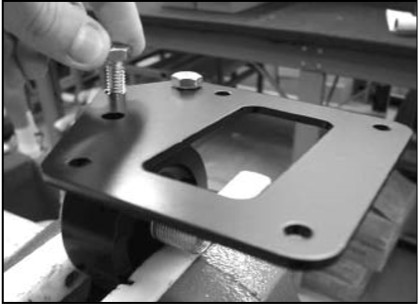
12. Place the four thin ¼” washers over the ¼”-20 bolts, and insert them through the mounting holes in the adapter plate from the Filter Mount side of the plate.
13. Place the thick ¼” washers on each of the ¼”-20 bolts on the bumper side of the Adapter Plate. The washers space the Adapter Plate away from the bumper support, providing clearance for the bolt heads installed in Step 11. Use of a sticky substance between the Adapter Plate and the spacers, such as a light coating of the sealant used in Step 9, can help prevent the washers from falling off during attachment to the bumper support.
14. Attach the Adapter Plate to the bumper support by inserting the ¼”-20 bolts of the plate assembly through the mounting holes drilled in Step 8. The two supplied nut plates must be positioned inside the bumper support to receive the bolts. Clamping the Adapter Plate to the bumper support while positioning the first nut plate can also aid this step.
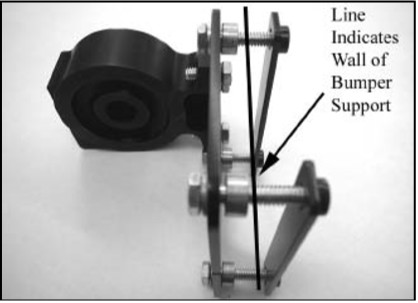
15. Tighten all four adapter plate bolts to 10 ft-lb. Note: While the photo below shows the oil lines already installed, they should not be installed until Step 22.
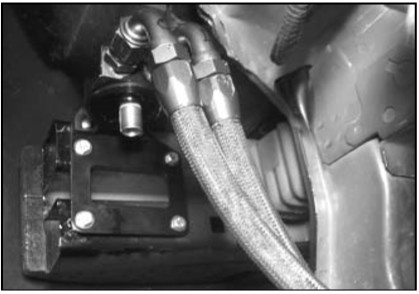
Engine Block Adapter Installation
16. Coat the tapered pipe threads of the two -10 AN to pipe fittings with the supplied Loctite Thread Sealant. Do not coat the leading thread. Place the Engine Block Adapter into a vise with “soft jaws” and install each of the two adapter nipples into one of the ports of the Engine Block Adapter. Tighten the adapter nipples. The tapered pipe threads form a wedge and the fittings do not bottom. Do not over-tighten, or damage will result.

17. Lube the Engine Block Adapter rubber gasket with motor oil.
18. Place a drain pan under the oil filter and remove the oil filter. Be sure the rubber filter gasket is removed with the filter.
19. Loosely attach the Engine Block Adapter at the OE filter location on the block. Rotate the Engine Block Adapter such that the adapter nipples face toward the front of the car.
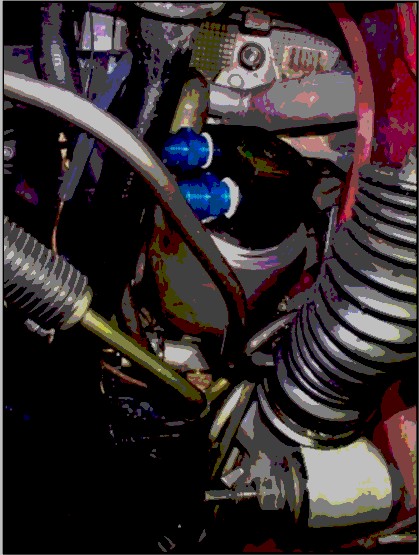
Oil Line Fabrication And Installation.
20. Remove any tape and Inspect the ends of the supplied oil line hose. Choose the end of the hose that is in best condition. Install a 90-Degree fitting onto the this end of the hose. Start by disassembling the red socket from the blue nipple on one of the provided 90-Degree fittings. Install the red socket onto the end of the hose by twisting the socket COUNTER-CLOCKWISE over the hose. Butt the end of the hose up to the base of the threads of the red socket.

21. Use a felt-tip pen to mark the hose at the base of the socket, so that you can tell if the hose is getting pushed out during the remaining steps of the fitting installation.
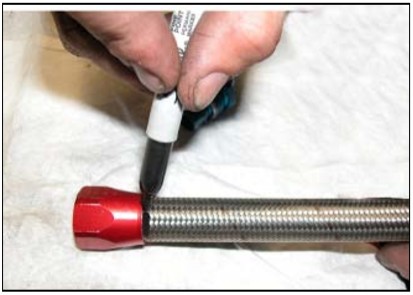
22. Use motor oil to lubricate the threads and the tip of the blue nipple that will be inserted into the hose. Use motor oil to lubricate the inside and cut end of the hose. Place the blue nipple in a vise. Hold the HOSE (not the red socket), and push the hose onto the blue nipple far enough to engage the threads of the red socket. Turn the HOSE to thread the red socket onto the blue nipple. Tighten as far as possible by hand.

23. When you can no longer tighten the fitting by hand, use appropriate size wrenches to tighten the fitting. Tighten the fitting until the red socket is within 1/16” from bottoming on the blue nipple. Do NOT use adjustable or oversize wrenches, or you will damage the fitting.
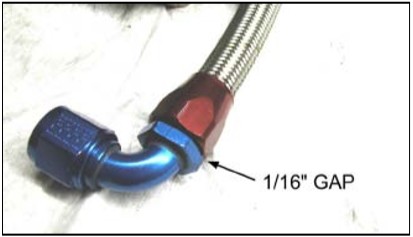
24. Make sure the mark made at the base of the socket at Step 21 has not moved relative to the socket by more than 1/16”. If it has, remove the fitting and return to Step 20.
25. Hand tighten the attached 90-Degree fitting onto the adapter nipple of inboard port of the Remote Filter Mount (the adapter nipple closest to the radiator support).
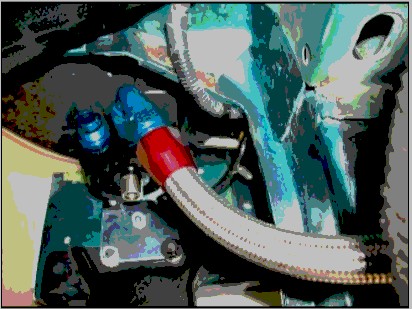
26. Route the hose under the frame rail, over the antisway bar and the clutch cable to the Engine Block Adapter. The specific routing should be based on your personal preference and vehicle configuration.
NOTE: It is important to understand that each one of the Remote Filter Mount ports must be connected to the correct port of the Engine Block Adapter. Specifically, the inboard port of the Filter Mount must be attached to the lower port of the Engine Block Adapter. This is the RETURN line. The outboard port of the Filter Mount must be attached to the upper port of the Engine Block Adapter. This is the FEED line. This configuration ensures proper oil flow in the system.
27. With the hose routed properly, hold it next to the straight fitting on the Engine Block Adapter. Mark the hose at the position indicated by the arrow. It will be cut to length in Step 29.
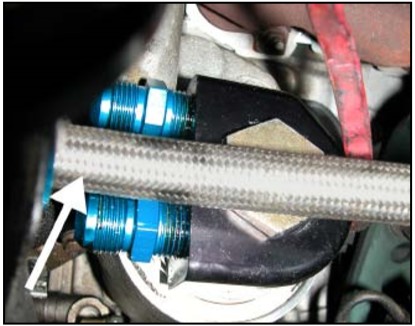
28. Remove the hose from the Remote Filter Mount and remove the hose from the car.
29. Very tightly wrap tape around the hose centered over the mark made at Step 27. Use a sharp 32 teeth per inch hacksaw and cut the hose through the center of the tape at the mark. Do not be tempted to use a hacksaw blade with fewer than 32 teeth per inch! Trim frayed ends of the hose with a sharp pair of diagonal cutters.
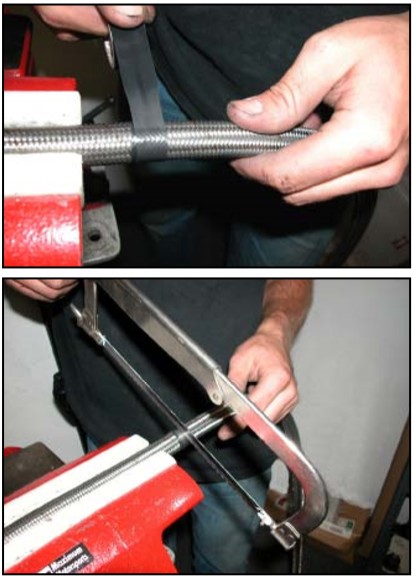
30. Remove the tape and repeat steps 20-24 for attaching a STRAIGHT fitting onto the cut end of the hose.
31. For reference, apply a piece of tape on this oil line. The tape will designate the RETURN oil line, which will be attached between the inboard port of the Remote Filter Mount and the lower port of the Engine Block Adapter.
32. Repeat steps 20-30 to make a second oil line to attach the FEED line between the OUTBOARD port of the Remote Filter Mount and the UPPER port of the Engine Block Adapter.
33. Attach the 90-Degree fitting of the FEED oil line onto the outboard adapter nipple of the Remote Filter Mount, and tighten to 15 ft-lb. Use a crow-foot socket and a small torque wrench.
34. Route the FEED oil line under the frame rail, and over the anti-sway bar and clutch cable to the Engine Block Adapter. Do not attach the oil line to the Engine Block Adapter yet.
35. Attach the 90-Degree fitting of the RETURN oil line to the inboard adapter nipple of the Remote Filter Mount, and tighten to 15 ft-lb.
36. Route the RETURN oil line under the frame rail, and over the anti-sway bar and clutch cable to the Engine Block Adapter.

37. Attach the STRAIGHT fitting of the FEED oil line to the upper adapter nipple of the Engine Block Adapter and tighten to 15 ft-lb.
38. Attach the STRAIGHT fitting of the RETURN oil line to the lower adapter nipple of the Engine Block Adapter and tighten to 15 ft-lb.
39. Fine tune the orientation of the Engine Block Adapter in order to give the best oil line routing. Tighten the hex head on the Engine Block Adapter. The Engine Block Adapter uses a rubber oil filter gasket. Do not over tighten to avoid damage to the sealing surfaces.
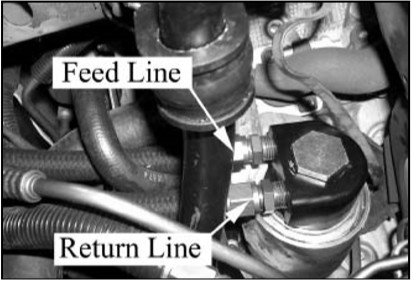
WARNING: Braided steel line is very abrasive. Normal engine and driving vibrations will cause it to wear through other items near it if it is not properly insulated.
40. Wrap each braided steel line separately with the supplied spiral wrap material as shown in the photo. DO NOT wrap them together, or the lines will wear through each other, with disastrous results.
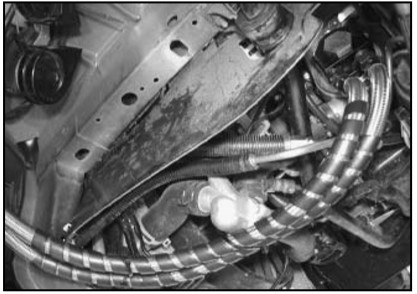
41. Use the supplied zip ties to secure the oil lines as needed.
Finishing The Installation
42. Fill the provided oil filter with oil and hand tighten the filter on the Remote Filter Mount until the seal contacts the Remote Filter Mount. Tighten the oil filter 1/2 turn further.

43. Re-attach the driving light connector to the driving light.
44. Start the engine and examine all of the oil lines, oil line connections, filter, and block connections carefully to ensure that everything is tight and that there are no leaks. Turn off the engine after examining the oil lines and oil line connections.
45. Re-attach the driver side wheel. Torque the lug nuts to the appropriate wheel or vehicle manufacturer’s specification.
46. Lower the front of the car to the ground.
47. Let the engine sit for 10-15 minutes to allow the oil to drain back into the pan. Check the oil level. Add oil, if necessary.
